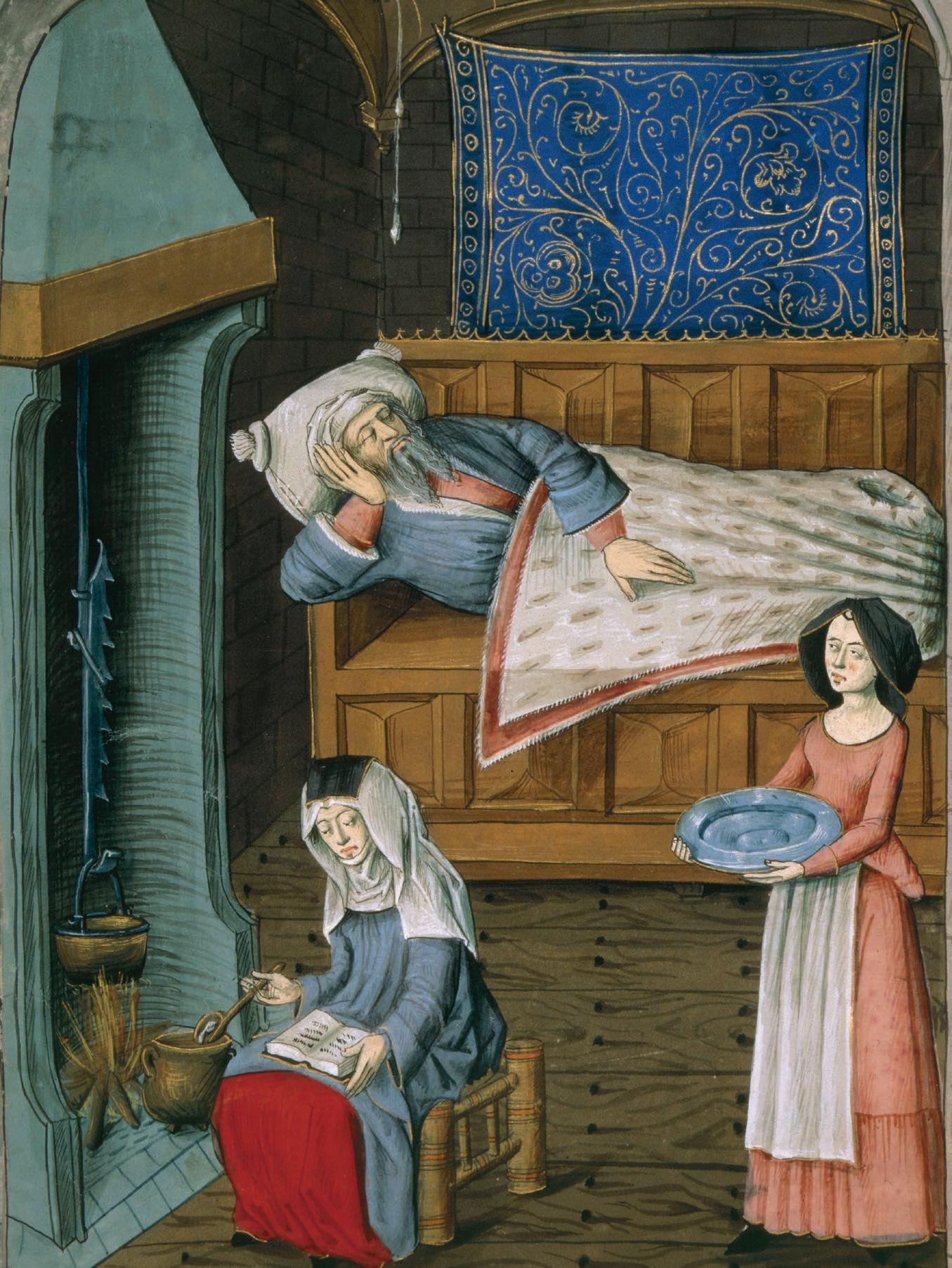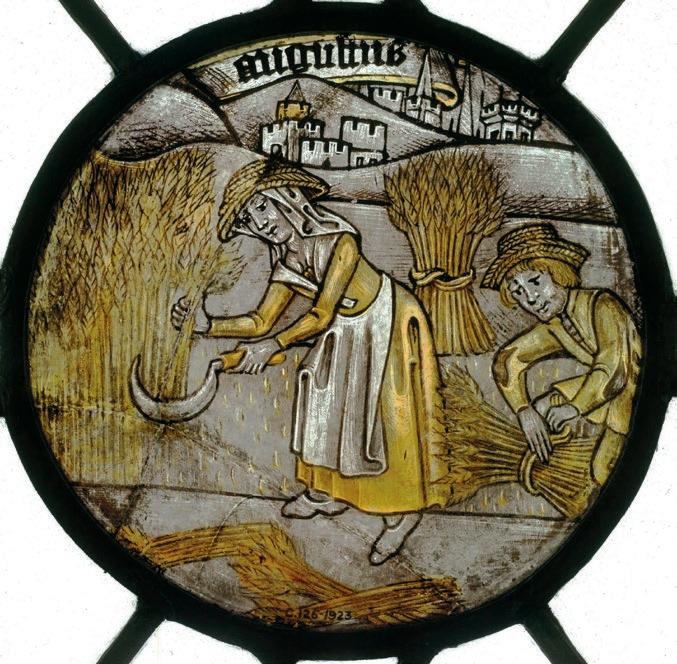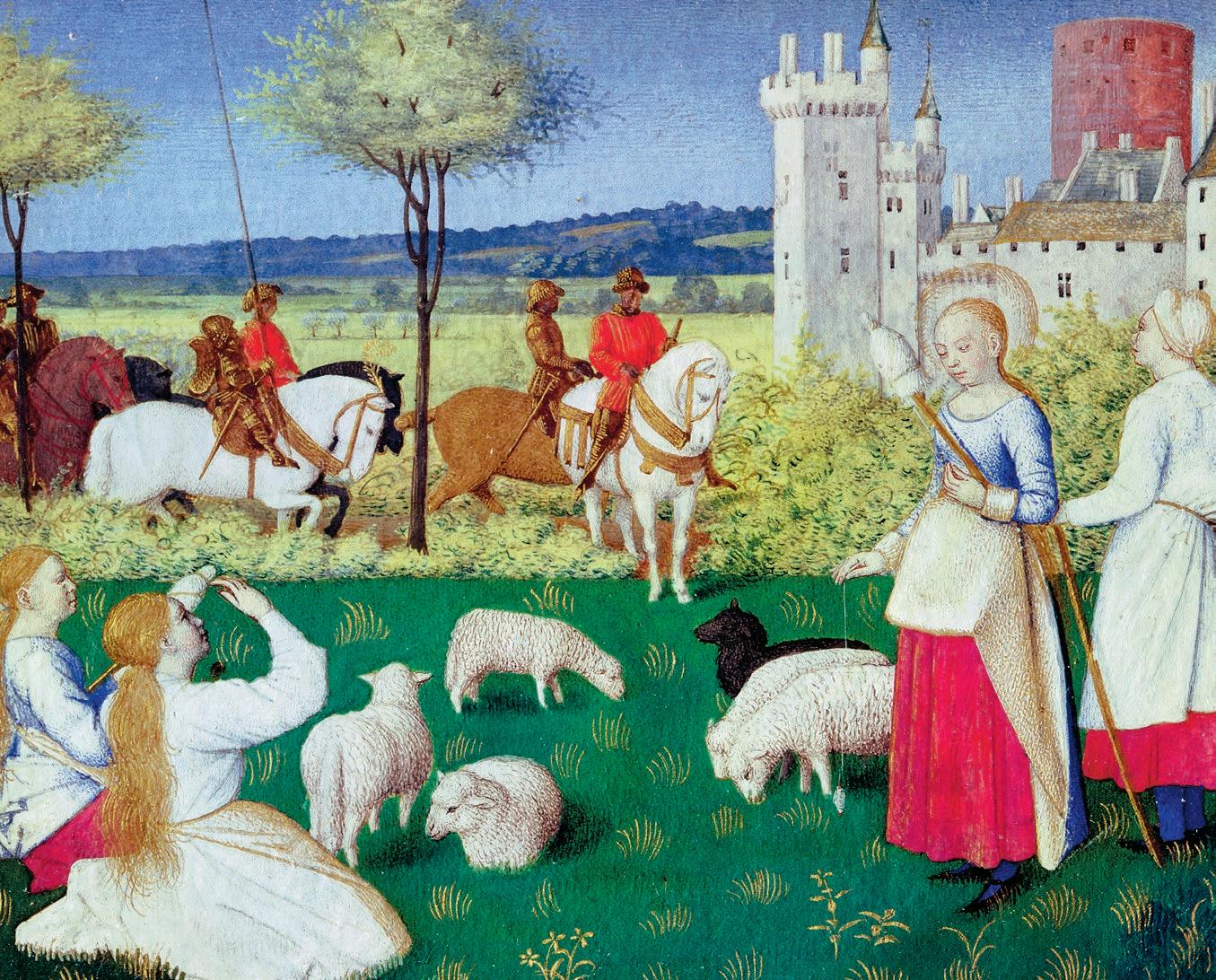






ILLUMINATING THE WORLD OF PEASANTS, NUNS, AND QUEENS

Medieval Europe was ruled by the Three Estates, the idea that society was neatly divided into three groups: the church, the nobles, and the commons. While Christendom was a patriarchy, women were present in all three of these estates. At the start of our period, the commons meant the peasants, but as the Middle Ages progressed, a new class began to spring up across Europe. Although it was not quite the “middle class” as we may consider it today, the growth in trade and skilled professionals led to a bourgeois class made up of reasonably wealthy—and powerful—merchants and craftspeople. As the medieval period drew to a close, those who inhabited this rank found themselves in significant positions of influence in urban centers across Europe, with access to royal courts opened up to them through their affluence. Though women in this rank did not gain political power as the men around them did, their lives were substantially different from those of their peasant sisters.
Regardless of their station, all women had to work. As we’ll see, the world of work was open to peasant and professional women. What did it mean to be a medieval woman who earned a living? The first point to consider is how to define work. Throughout time, women’s work has traditionally been ignored, minimized, and marginalized. Raising children, cooking, keeping a house clean, overseeing the family, supporting a husband, and growing food, while vital for the maintenance of society, were often (and still can be) not considered “real work.” Many women in the medieval period were housewives whether they also worked for a salary or not. Though she and her contemporaries did not consider the role to be a “job,” the medieval housewife’s contribution to maintaining the family unit was still seen as vital. Women were the lifeblood of the home, and without them, how was a man to work and build his legacy?
The plethora of roles a woman was expected to perform did not go unacknowledged. The Ballad of the Tyrannical Husband, the tale of an angry man and his good wife, was composed in the late fifteenth century and survives in a single London merchant’s book of texts. The grumpy husband came home one day from plowing and complained that his wife had not prepared dinner for him. He queries what she could possibly have spent her day doing, claiming she had nothing to do but sit at home or gossip with the neighbors. The

The Ballad of the Tyrannical Husband revealed the neverending list of tasks peasant women had to complete in a day. As described in the Ballad, this woman is shown feeding chickens while holding her distaff under her arm, ready to return to spinning thread once the animals have been cared for, balancing tasks just like the wife of the ballad.
Luttrell Psalter, fol. 166v, England, 1320–40 British Library, London; Add MS 42130
indignant wife reels off a list of her tasks. Having been up all night caring for their children, she had risen before her husband, milked the cows, and turned them into the field. Across the course of the day, she proceeded to make butter and cheese, continued to care for the crying children, fed the chickens, ducks, and geese, then baked bread and brewed ale before processing flax, spinning wool, and making clothes for the family. Eventually the couple make a wager, whereby the husband will be the housewife for a day while the wife goes out to plow. The end of the ballad is lost, but its composition certainly suggests that the wife succeeds in the field, while caring for the home ends disastrously for the husband.1
Being a housewife is hard today, and it was hard in the medieval period. Life was difficult, and household tasks were laborious and arduous, with limited technology to make them easier. It is important that we recognize this aspect of life for common women of the time. But the tasks that women were expected to carry out as wives and mothers were important in another sense, as they influenced what society deemed acceptable as work for women. As women moved into the world of work outside of the home, their career opportunities were directed by the work they already did within the home. The greatest opportunities, and the greatest respect, were found in professions that were an extension of the role of housewife: that of provider of food and textiles, of caregiver, and of household manager. This pattern is very much followed in the art of the period, as peasants and professionals are most often depicted

working. While women can be seen occasionally performing tasks less common for their gender, most are shown farming, caring for animals and children, and working with textiles. Manuscript drawings, in particular, are a ripe place to find ordinary women; while individual holy or noble women sometimes had statues erected in their honor or were shown in shimmering stained glass windows or beautifully intricate tapestries, peasant women found a place in the doodles and marginalia that accompanied written pieces of the period. These images can provide us with great insight into how these women dressed and undertook their jobs and daily lives, bringing them to the foreground when the written records would otherwise ignore their presence.
While some writings acknowledged how much work a medieval housewife had to undertake, artworks sometimes poked fun at the notion. Astride a donkey, this woman carries a baby, two ducks, and a cooking pot while spinning a distaff and herding animals. The caption reads “I have plenty of household goods; otherwise I would not be so important.”
The Wandering Housewife, Switzerland, 1470–80 Wool and linen tapestry panel, 33⅞ × 42⅞ in. (86 × 109 cm) Glasgow Museum, Scotland
↓ Although women rarely did the most physical farm labor, they were required to help during every season. In this image, a woman waits with a rake to gather up the crops that the man has harvested with a scythe.
Pietro Cres C enzi , Ruralia Commoda (Speyer, Germany: Peter Drach), 1493
↘ The labors of the months was a popular motif in medieval artwork, depicting different tasks based on the season for each month of the year. Many of these labors involved peasants, and so these images provide insight into everyday life. This stained glass roundel shows the month of August, represented by a woman bending over to harvest grain with a sickle.
Labours of the Months (August), England, 1450–75
Stained glass panel, diameter: 8⅜ in. (21.5 cm)
Victoria and Albert Museum, London

As the year 1000 arrived, towns and cities existed in Europe, but urban centers were limited. There were a few blooming metropolises, and countries and states were still forming. While trade flourished, in many places in Europe it was limited in scope. Many people lived rural, agricultural lives based on subsistence and serving their local lords. Women were central to this rural lifestyle, and they continued to be as the Middle Ages progressed.
Agriculture was defined by the environment, the weather, and the seasons. If you couldn’t grow or trade goods somewhat locally, then you didn’t obtain them unless you had the money and power to do so. Within the Three Estates system, feudalism and similar structures dominated in Europe. Peasants may have had their own small holdings, but they were not enough to live on and were often rented from their local lords. Peasants also had to work the land so their liege could make a living, using their spare time to manage their own crops and animals. The physical labor of growing crops was grueling. The toil of pulling the plow alongside the oxen and swinging scythes to harvest the crops was largely reserved for men, but women still needed to participate wherever possible. They would weed the crops and tidy the fields during the growing season and help collect chaff, stalks, and kernels left behind by the men as they harvested.
Certain crops that required less strength to care for easily lent themselves to women’s work. In Seville, a seasonal balance was


found between men’s and women’s work. The majority of the region’s peasants owned small farms planted with grapevines that could be managed most of the time by women. The large estates of the major landholders were given over to cereals and olives, which both sustained the region and gave it flourishing trade. During July and August, the cereals required harvesting, and this work was carried out exclusively by men in the region, who would leave their homes in large numbers to work for the estates. In September, the grapes had ripened on the vines of the peasants, who were now free to reap their own rewards.
Then, when November arrived, the olives of the great estates were ready for picking. Collecting the vast numbers of olives could last into the start of January, and while it was tiring, as it required working every day from dawn to dusk, it was not too physically demanding. For this harvest, the women of Seville traveled to the estates and spent the next few months living in specially built harvesters’ houses on the farms. Contracted to work by the basketful, they were known as cogederas, or “catchers.” Women of all ages undertook this work, and they would have spent the sunlight hours toiling away. Many brought their children with them—not to supervise them as their mothers but because the children were active participants in the harvest even from as young as six years of age. The women’s contracts for olive harvesting could be drawn up months in advance, with payment being made at the point of signing. Many families used these payments to stretch their money during the spring, when there was little work available, paying off the debt with their labor through the autumn and winter. While the women were away, the men would stay home and tend to their own vines, pruning and preparing them for winter.2
Many other European regions had seasonal cycles of labor divided between men and women. Generally, though, women’s farmwork was multifaceted, and they were expected to react to the needs of the moment. While they had regular, daily jobs they needed to do, women were considered cheap, available labor to be on hand as and when needed, such as during harvest. Pastoral agriculture, or animal husbandry, is where women’s labor was particularly focused. It was usually women who cared for animals, feeding and watering them, turning them into the fields, and collecting their produce, whether
↑ The women of Seville harvested olives from estate farms and grapes from their home vines, and were usually paid by the basketful. This woman harvests grapes in the calendar page for September.
Follower of the Egerton Master (active c. 1405–1420)
Book of hours, fol. 9, France (Paris), c. 1410 Getty, Los Angeles; Ms. Ludwig IX 5
↓ A woman churns butter, depicted in the margin of a manuscript.
Arthurian Romances, fol. 300v, France, 1275–1300
Beinecke Rare Book and Manuscript Library, Yale University, New Haven, CT; Beinecke MS 229


↑ A woman milks a cow at the top of this bestiary page—this farmyard task usually fell to women.
The Bodley Bestiary, fol. 41v, England, 1226–50 Bodleian Libraries, University of Oxford, England; MS. Bodl. 764
→ Art can be an excellent way to study peasant women, who may not be found otherwise in written records. It can shed light on the clothes they wore and the tasks they carried out daily, as in this drawing of a peasant couple. The woman carries a goose under her arm, while the man holds a club over his shoulder from which dangles a basket of eggs.
Master of the Amsterdam Cabinet (active late 15th century) Peasant Couple, Germany, 1470–75
Drypoint on paper, 3⅛ in. × 2⅛ (7.9 × 5.6 cm)
Rijksmuseum, Amsterdam; RP-P-OB-925
it be eggs, wool, milk, or feathers. They were also expected to undertake the initial processing of these products—churning milk into butter and cheese, spinning wool into thread, or cooking food for the family.
A common task for rural women was the brewing of ale. Despite pervasive myths, medieval people did not drink alcohol because it was safer than water—they generally had access to clean water sources, and alcohol was purely for enjoyment or nutrition. At times when the harvest was poor, the least wealthy members of society would not have wasted their limited grains in brewing ale, but in normal years it was a common household task for women. To create ale, grains were soaked to release their sugars and then heated in a kiln. The concoction was then crushed and mixed with hot water in order to dissolve the sugars, and finally the liquid was filtered out from the rest of the mixture and left to ferment. Although its manufacture was a relatively simple process, ale did not preserve well and so had to be brewed regularly in small quantities. In most rural households, the women would have made ale a couple of times a month, the family consuming it as they went, but large households and religious centers may have had a more industrial-scale production line. In plentiful times, any extra ale produced by the housewife could always be sold for extra coin at market.3
Not all rural women were housewives; another significant proportion of women in rural Europe who had to engage in agriculture were religious women. As we will come to see, many nuns lived in rural communities sequestered away from busy urban centers so


that they could focus their lives on prayer, removed from the sins of the common people. Despite this isolation, and although many nunneries had servants and agricultural workers to help provide for them, religious women across the Middle Ages got their hands dirty with this type of work too.
Although peasant women could be involved in any aspect of farmwork, it was considered unbecoming for religious women to engage in the hardest areas of farm labor. But they did raise animals and grow crops seen as more suitable to women’s work—particularly in vineyards. Nuns also became associated with caring for sheep, which provided not only food but also much-needed cloth to work with. These were not always small-scale farmholdings—the nuns at the Icelandic convent Kirkjubæjarklaustur kept more sheep not only than any other religious house in the country but even more than any farm in Iceland.4
While much of Europe was divided into private estates and peasant smallholdings, there were also swaths of common land, which any member of society could make use of to supplement their living. This land could be used to graze animals, or it could hold valuable produce, including bushes of wild fruits or other useful plant matter such as rushes and reeds, which were brought into the home to use as flooring. These smaller gathering tasks were, again, often relegated to women and children. The poorest in society in various regions tended to consume a mainly vegetarian diet, eating only low-quality meat from older animals that had outgrown their use as working beasts. Anything that a woman could bring to the house through extra work was important to the survival of the family unit.5
Among the most common kinds of tasks peasant women undertook were those related to textiles. All the wool gathered from sheep had to be processed before it was used, and for much of our period, this initial processing was done at a local level. Cloth may have been refined, decorated, and turned into luxurious products in towns and urban centers, but it was initially purchased in a fairly raw form from rural areas. Women would shear sheep on their smallholdings and then, using their distaffs, spin wool—or linen or flax—into threads that would be sent to looms in their local town or village, where they would be processed.6 The image of a woman with a distaff was pervasive in the medieval period, and countless images can be found of women, from peasants depicted in the margins of a manuscript to glorious multicolor full-scale images of the Virgin Mary, using distaffs.
That even the most holy woman in Christianity was associated with this task showed its importance to medieval Europeans and how highly valued this work was. Around 1100, the bishop of Rennes in Brittany wrote a poem called the Book of Ten Chapters, and within his fourth chapter he praises women who use the spindle and weave yarn, proclaiming that, “if they were lacking, the quality of our life would decline.” In the same vein, in the following century, Italian noble Philip of Novara explained that women of all classes should learn how to spin and sew, because then the poor would have a skill that could earn them money, and the rich would understand how

others in society had to work. He too highlights that there is great reward and no shame to be found in these skills, for even “the glorious mother of God deigned to work cloth and to spin.”7
In fact, images of the Virgin Mary undertaking the ordinary tasks of medieval women found great popularity as the period developed, particularly for religious women. The Virgin Mary was the ultimate role model for nuns, and whatever the Mother of God did, so too should they. Both manuscripts and paintings increasingly depicted Mary at a loom or doing other daily household chores. A panel from Cologne made toward the end of the fifteenth century shows Mary
Here, women use distaffs to spin wool from sheep into thread in an illustration from the martyrdom story of Saint Margaret of Antioch.
Jean Fouquet (c. 1420–1480) Book of Hours of Étienne Chevalier, France, 15th century Musée du Louvre, Paris; MI 1093, recto